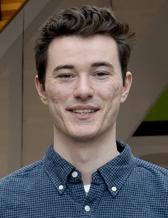
- Home
- Research
- Find research
- Adam Turner: Preventing biofilm-related implant failures
Adam Turner: Preventing biofilm-related implant failures
Implant-related infections are a serious problem in healthcare. Adam Turner’s research explores new materials and methods to prevent these infections, focusing on the challenges posed by Staphylococcus aureus biofilms.

ADAM TURNER
Dissertation defense: 13 September 2024 (click for details)
Doctoral thesis: Biomaterial-induced inhibition of Staphylococcus aureus biofilm formation
Research area: Biomaterials
Sahlgrenska Academy, The Institute of Clinical Sciences
Medical devices are used extensively in modern medicine to restore or prevent loss of anatomical function due to trauma, disease, and age. While these devices are quite successful, they can fail due to infection.
The burden of implant-related infections on the patient and healthcare is great, resulting in revision surgeries, prolonged disability, psychological trauma and even death.
Staphylococcus aureus is the most notorious causative pathogen due to its extensive toxicity, resistance to antibiotics, and capacity to form biofilms.
“Those biofilms are slimy layers of aggregated bacterial cells on implants or tissues. As all medical devices have a risk of infection, new infection control strategies are needed,” says Adam Turner, a doctoral student at the University of Gothenburg.
He works at the Department of Biomaterials at the Institute of Clinical Sciences, as part of the Marie-Curie European Training Network BIOREMIA.
The research in Adam Turner’s doctoral thesis investigates alternative treatments and new antimicrobial materials to treat or prevent implant-related infections.

Significant findings to fight biofilm
He highlights the most significant findings from his research and their practical implications:
- Sodium salicylate, a molecule related to aspirin, can block the communication system of Staphylococcus aureus leading to fewer harmful bacterial toxins and an enhancement of the effect of antibiotics. Antivirulence compounds, such as sodium salicylate, do not kill but weaken bacteria, helping our immune system to eradicate the infection, without the risk of developing resistance.
- A zinc oxide coating enhances the degradation of an iron-manganese biomaterial, making it suitable for biodegradable medical devices like fracture fixation screws. It is compatible with bone cells and reduces the growth and biofilm of Staphylococcus aureus.
- Copper-electroplated titanium kills Staphylococcus aureus, decreasing the formation of biofilm, and improving the ability of immune cells to destroy bacteria.
- PEGylated polymer coatings on titanium significantly disrupts Staphylococcus aureus biofilm, improving the effect of several antibiotics to eradicate the biofilm.
“We have also identified important cellular and molecular interactions between immune cells and Staphylococcus aureus on surface modified titanium. Our findings show that if bacterial cells colonize an implant surface, immune cells cannot fulfil their antimicrobial function, resulting in infection and implant failure. This highlights the need for anti-biofilm strategies for implants,” says Adam Turner.

Reflections on the doctoral journey
What has been enjoyable and rewarding about your doctoral project?
“Being a part of the BIOREMIA European Training Network has been incredibly rewarding. The friends made and experiences during our tenure together have been unforgettable. Without my colleagues at the Biomaterials department, the PhD journey would have been far more difficult and much less enjoyable.”
What has been challenging?
“Other than the typical workload of a PhD, the most challenging aspect has been the interdisciplinarity. My background is mainly biology, and being introduced to the world of materials science was complex, confusing, and challenging. However, the knowledge shared by my colleagues at the lab and in the BIOREMIA network made this complexity much less daunting.”
Text: Jakob Lundberg